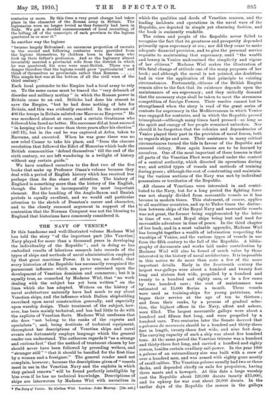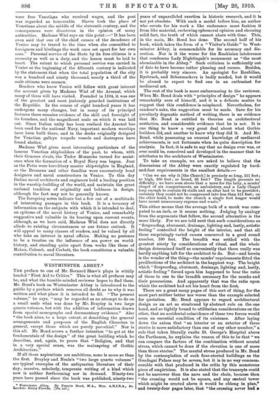THE NAVY OF VENICE.* IN this handsome and well-illustrated volume
Madame Wiel has told the story "of the important part [the Venetian] Navy played for more than a thousand years in developing the individuality of the Republic " ; and in doing so has embodied results of laborious research into records of the types of ships and methods of naval administration employed by that great maritime Power. It is true, no doubt, that every historian of the Republic has necessarily recognised the paramount influence which sea power exercised upon the development of Venetian dominion and commerce ; but it is equally true, as remarked by Madame Wiel, that " no work dealing with the subject has yet been written" on the lines which she has adopted. Writers on the history of naval architecture naturally have had much to say about Venetian ships, and the influence which Italian shipbuilding exercised upon naval construction generally, and especially upon warship design. Their treatment of the subject, how- ever, has been mainly technical, and has had little to do with the exploits of Venetian fleets. Madame Wiel confesses that she does "not belong to the ranks of the experts and specialists "; and, being destitute of technical equipment, throughout her descriptions of Venetian ships and naval events she fortunately employs language which the general reader can understand. The authoress regards it "as a strange and curious fact" that the method of treatment chosen by her should never have been followed by preceding writers, and " stranger still " " that it should be handled for the first time by a woman and a foreigner." The general reader need not complain, however ; because the descriptions given of "vessels most in use in the Venetian Navy and the exploits in which they gained renown" will be found perfectly intelligible by him even if he has no technical knowledge. Descriptions of ships are interwoven by Madame Wiel with narratives in
I no Navy of Venice. By Alethea Wiel. London : John Murray. [15e. net.]
which the qualities and deeds of Venetian seamen, and the leading incidents and operations in the naval wars of the Republic, are depicted in simple yet charming fashion, and the book is eminently readable.
The rulers and people of the Republic never failed to recognise the fact that its greatness and prosperity depended primarily upon supremacy at sea; nor did they cease to make adequate financial provision, and to give the personal service requisite to maintaining that supremacy, until " the wealth and luxury in Venice undermined the simplicity and vigour of her citizens." Madame Wiel makes the illustration of this fatal change of attitude one of the many purposes of her book ; and although the moral is not pointed, she doubtless had in view the application of that principle to existing circumstances. Fortunately, citizens of the British Empire remain alive to the fact that its existence depends upon the maintenance of sea supremacy ; and they unitedly demand that the necessary steps shall be taken to meet the strenuous competition of foreign Powers. Their resolve cannot but be strengthened when the story is read of the great series of contests for supremacy in the Mediterranean in which Venice was engaged for centuries, and in which the Republic proved triumphant—although many times hard pressed—so long as the spirit and energy of her people remained unbroken. Nor should it be forgotten that the colonies and dependencies of Venice played their part in the provision of naval forces, both as regards ships and men. Their assistance in many critical circumstances turned the tide in favour of the Repuhlic and ensured victory. Here again lessons are to be learned by ourselves. One of the most important of these lessons is that all parts of the Venetian Fleet were placed under the control of a central authority, which directed its operations during war, and settled types of vessels and methods of training during peace ; although the cost of constructing and maintain- ing the various sections of the Navy was met by individual possessions or territories of the Republic.
All classes of Venetians were interested in and contri- buted to the Navy, but for a long period the fighting force was not sharply divided from mercantile vessels as it has become in modern times. This statement, of course, applies to all maritime countries, and up to Tudor times the distinc- tion between ships of the Royal Navy and mercantile vessels was not great, the former being supplemented by the latter in time of war, and Royal ships being lent and used for mercantile adventure in time of peace. In the third chapter of her book, and in a most valuable appendix, Madame Wiel has brought together a wealth of information respecting the warships of Venice, and the various types of vessels in use from the fifth century to the fall of the Republic. A biblio- graphy of documents and works laid under contribution by Madame Wiel will also be found of much value by those interested in the history of naval architecture. It is impossible in this notice to do more than note a few of the more important details. Early in the fourteenth century the largest war-galleys were about a hundred and twenty feet long and sixteen feet wide, propelled by a hundred and twenty to a hundred and eighty oars, or in a few cases by two hundred oars ; the cost of maintenance was estimated at 15,000 florins a month. These vessels were used as training-ships for young patricians, who began their service at the age of ten to thirteen ; and from their ranks, by a process of gradual selec- tion, the highest offices in the Navy, afloat and ashore, were filled. The largest mercantile galleys were about a hundred and fifteen feet long, and were propelled by a hundred oars. Two centuries later the Senate decreed that a galeazza da mercanzia should be a hundred and thirty-three feet in length, twenty-three feet wide, and nine feet deep. The carrying capacity of such a ship was about five hundred tons. At the same period the Venetian trireme was a hundred and thirty-three feet long, and carried a hundred and eighty rowers, besides certain auxiliary sail-power. In the year 1600 a galeone of an extraordinary size was built with a crew of over a hundred men, and was armed with eighty guns mostly of small calibre. The Venetian galeone usually had two or three decks, and depended chiefly on sails for propulsion, having three masts and a bowsprit. At this date a large warship cost the Republic about 120,000 ducats (nearly 215,000), and its upkeep for war cost about 26,000 ducats. In the earlier days of the Republic the rowers in the galleys
were free Venetians who received wages, and the post was regarded as honourable. Slaves took the place of Venetians about the middle of the sixteenth century, and the consequences were disastrous in the opinion of many authorities. Madame Wiel says on this point :—" It has been even said that one of the chief causes of the decadence of Venice may be traced to the time when she committed to foreigners and hirelings the work once set apart for her own sons." Personal service of the State by its free citizens is a necessity as well as a duty, and the lesson must be laid to heart. The extent to which personal service was carried in Venice at the beginning of the fifteenth century is indicated by the statement that when the total population of the city was a hundred and ninety thousand, nearly a third of the male citizens were seamen.
Readers who know Venice will follow with great interest the account given by Madame Wiel of the Arsenal, which many of them will have visited. Founded in 1104, it was one of the greatest and most jealously guarded institutions of the Republic. In the course of eight hundred years it has undergone many changes, but in many of its principal features there remains evidence of the skill and foresight of its founders, and the magnificent scale on which it was laid out. Since Italian unity has been realised the Arsenal has been used for the national Navy, important modern warships have been built there, and in the docks originally designed for Venetian galleys torpedo vessels and destroyers have found shelter.
Madame Wiel gives most interesting particulars of the famous Venetian shipbuilders of the past, to whom, with their Genoese rivals, the Tudor Monarchs turned for assist- ance when the formation of a Royal Navy was begun. Just as the Petts were hereditary master shipwrights in England, so the Bressans 'and other families were successively head designers and naval constructors in Venice. To this day Italian naval architects and engineers hold a leading position in the warship-building of the world, and maintain the great national tradition of originality and boldness in design, although the fact may not be generally known.
The foregoing notes indicate but a few out of a multitude of interesting passages in this book. It is a treasury of information on the subjects with which it is intended to deal, an epitome of the naval history of Venice, and remarkably suggestive and valuable in its bearing upon current events, although, as we have said, Madame Wiel does not directly allude to existing circumstances or our future outlook. It will appeal to many classes of readers, and be valued by all who take an interest in naval affairs. Making no pretence to be a treatise on the influence of sea power on world- history, and standing quite apart from works like those of Mahan, Colomb, and Corbett, the book constitutes a valuable contribution to naval literature.















































 Previous page
Previous page